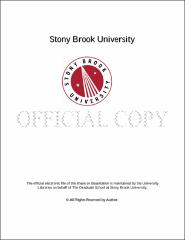| dc.identifier.uri | http://hdl.handle.net/11401/76688 | |
| dc.description.sponsorship | This work is sponsored by the Stony Brook University Graduate School in compliance with the requirements for completion of degree. | en_US |
| dc.format | Monograph | |
| dc.format.medium | Electronic Resource | en_US |
| dc.language.iso | en_US | |
| dc.publisher | The Graduate School, Stony Brook University: Stony Brook, NY. | |
| dc.type | Dissertation | |
| dcterms.abstract | The Large Hadron Collider has found an exciting excess at around 125 GeV. This excess appeared early on to behave as the long sought Higgs boson and with the 7 and 8 TeV data sets has been shown to behave very much like the Higgs boson responsible for the mass of the fundamental particles of the Standard Model. As the data continued to converge to the Standard Model predictions it became important to try and classify possible small deviations from the expected behavior. A manner of doing so, consistent with the symmetries of the Standard Model, is the use of effective field theories. Effective field theories are able to constrain the presence of new physics without directly probing the new physics energy scale. They are valid both for scenarios with new fundamental physics such as supersymmetry or new gauge sectors, as well as new strongly interacting scenarios where the degrees of freedom may present as pseudo Goldstone bosons of some new global symmetry such as composite Higgs models. In this dissertation we work in the effective field theory framework and using the available experimental data we place bounds on the coefficients of the relevant effective operators for Higgs physics. We consider two complementary realizations of the effective field theory: the linear realization, appropriate for a fundamental Higgs and new fundamental particles such as those predicted by supersymmetry, and the chiral or nonlinear realization, appropriate for composite Higgs scenarios. Additionally, by considering the effects of the new operators on other sectors, like triple gauge coupling data and electroweak precision data, we are able to further test the framework and devise signatures with potential to discriminate between the realizations. Finally we look at constraints on the operator coefficients from perturbative unitarity considerations, allowing us to then apply the results from our data analysis to predict the lowest energies at which perturbative unitarity may be violated signaling the possibility of new physics at energies consistent with those which will be probed during the impending Run 2 of the Large Hadron Collider. | |
| dcterms.available | 2017-09-20T16:50:59Z | |
| dcterms.contributor | Gonzalez-Garcia, Maria Concepcion | en_US |
| dcterms.contributor | Sterman, George | en_US |
| dcterms.contributor | Weinacht, Thomas | en_US |
| dcterms.contributor | Eboli, Oscar. | en_US |
| dcterms.creator | Corbett, Tyler | |
| dcterms.dateAccepted | 2017-09-20T16:50:59Z | |
| dcterms.dateSubmitted | 2017-09-20T16:50:59Z | |
| dcterms.description | Department of Physics. | en_US |
| dcterms.extent | 141 pg. | en_US |
| dcterms.format | Monograph | |
| dcterms.format | Application/PDF | en_US |
| dcterms.identifier | http://hdl.handle.net/11401/76688 | |
| dcterms.issued | 2015-12-01 | |
| dcterms.language | en_US | |
| dcterms.provenance | Made available in DSpace on 2017-09-20T16:50:59Z (GMT). No. of bitstreams: 1
Corbett_grad.sunysb_0771E_12421.pdf: 1375398 bytes, checksum: b2166723e7dfa488195820745d1a93b3 (MD5)
Previous issue date: 1 | en |
| dcterms.publisher | The Graduate School, Stony Brook University: Stony Brook, NY. | |
| dcterms.subject | Effective Field Theory, Higgs, LHC | |
| dcterms.subject | Particle physics | |
| dcterms.title | Effective Lagrangians for Higgs Physics | |
| dcterms.type | Dissertation | |

